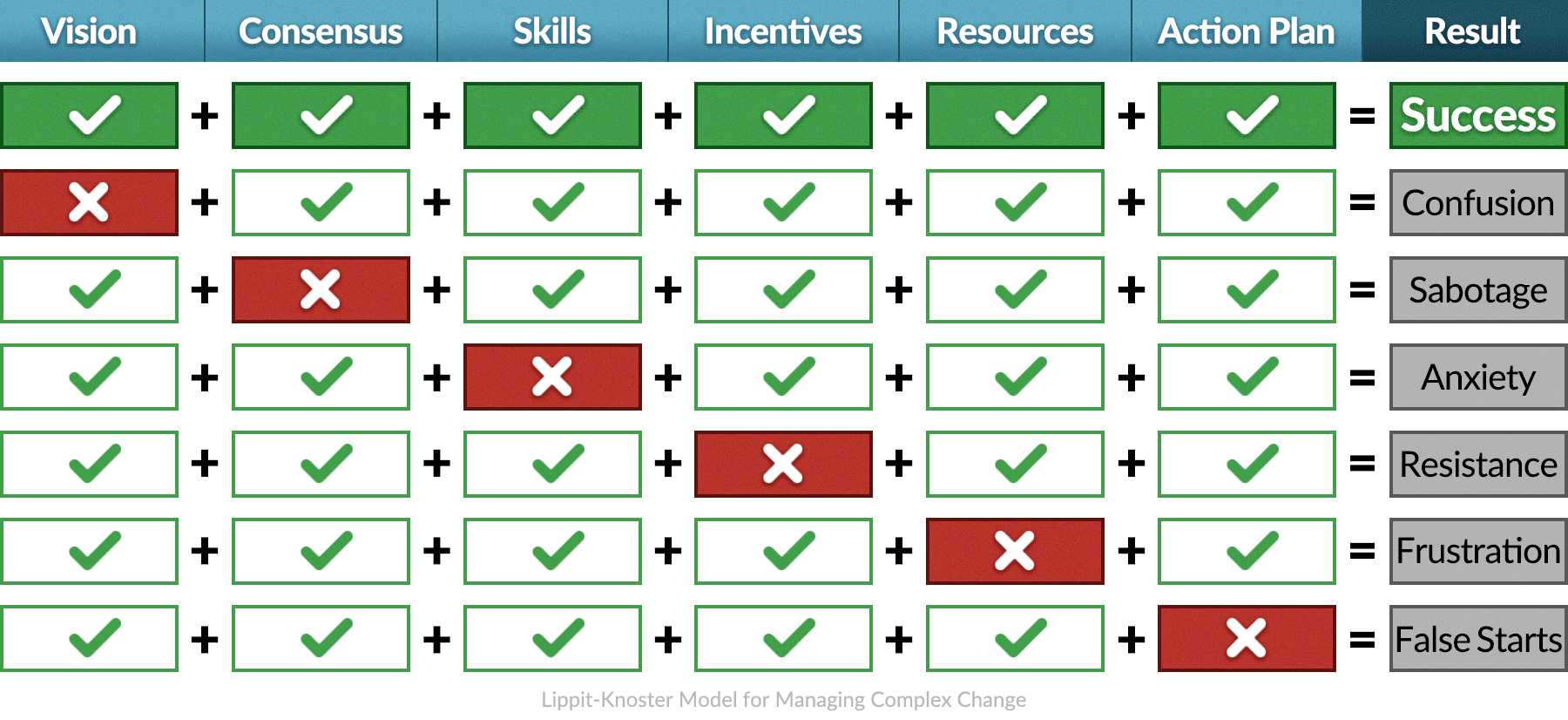In 1987, Mary Lippitt released a change management model that beautifully illustrated five key areas for organizational change. In 2000, Tommy Knoster extended Lippitt’s concept and included a sixth area of importance: consensus. It is now referred to as the Lippitt-Knoster Model for Managing Complex Change.
I use this model as part of my introduction to new team members. It is an effective way to allow your team to realize the symptom they are feeling and correlate it back to a root issue that needs improvement. Everything is constantly changing, and if you want a positive outcome, you’ll need to know how to identify what is missing in your organizational change management effort.

1. Weak Vision Leads to Confusion
If your team is experiencing confusion, a lack of vision is likely at the center of your change effort. This can also happen when the concept is misunderstood. Ensure that your team knows why the change is needed, how it fits into the business goals, and how you plan to mitigate potential risks.
2. Lack of Consensus Results in Sabotage
Intentional or not, sabotage may be an issue if a complete consensus for the change is not acquired. Whether the effort is top-down or bottom-up, the project champions need to garner a consensus among all stakeholders. During this step, don’t exclude interested parties outside your organization, such as clients, partners, and customers. If there is a conflict, try to resolve it using the overall vision or goals and see if the other side will commit to trying.
3. Limitation in Skills Brings Anxiety
Team members will likely experience anxiety if the proper skills to implement the change are unavailable. Do those involved in implementation possess the skills needed to bring the transition to life and maintain it once the transformation is complete? Can they be trained, or can additional resources be brought in? If the skills are not easy to attain, can you provide time for the necessary experimentation – trial and error – required for the team to gain experience?
4. Poor Incentives Yield Resistance
Your organization may feel reluctance or resistance when incentives are not aligned around the change. These do not need to be financially-based incentives. Will this effort save someone time, give them peace of mind, or allow them to reach their own goals? For best results, try to align the incentives with the project vision.
5. Lack of Resources Leads to Frustration
When your team is experiencing frustration, see if the correct resources have been assigned to the effort. Resources include staff, time, money, space, tools, etc. If you feel frustration within the team, identify which type of resource is lacking. Are you missing critical team members? Do your team members feel like they have time to correctly complete the tasks? Is there a belief that the project needs more budget to succeed? Perhaps you cannot fix things the way they would prefer, but you can acknowledge the resource issue and offer options to improve the situation.
6. Incomplete Action Plans End in False Starts
You will see one or more false starts within the project without a proper plan of action. It’s great to start with big-picture steps, but eventually, your project plan will need to get more granular and cover details related to all stakeholders – with their input. If you don’t have this in place, you’ll face periods of stalling shortly after you thought you were starting to see progress. You’ll see teams saying “we should” but not executing. Each team member will need a good understanding of when they are required and the scope of what they are being asked to do. You’ll need to allow for planning, execution, testing, and required iterations.
Conclusion
Change is a constant, but it never becomes easy. Organizational change of any size will see problems arise. Sometimes groups will miss, ignore, or simply push through roadblocks to their desired change. There are psychological stumbling blocks along the way too. Save your team some heartache and use the Lippitt-Knoster Model for Managing Complex Change to identify what your team is experiencing and resolve it back to what is missing from your change management.
If you need support in bringing your organizational change to life, reach out to your Perficient account manager, or use our contact page to begin a conversation.


Thank you for the Blog Brandon Luhring and for the insights!
Well written and practical advice. Thanks!